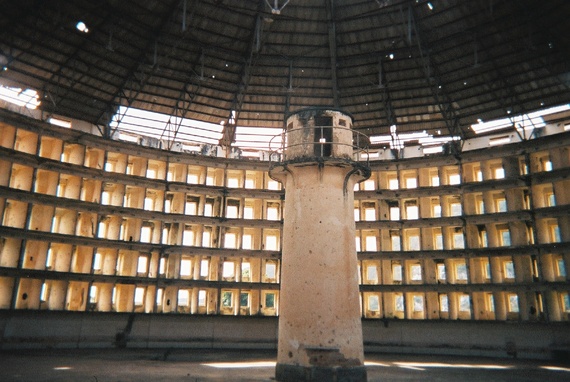Mass incarceration, perhaps the greatest social crisis in modern American history, is without parallel on a global scale.
by Matt Ford

An abandoned prison in Cuba (Wikimedia).
On Friday, the U.S. Sentencing Commission voted unanimously to allow nearly 50,000 nonviolent federal drug offenders to seek lower sentences. The commission’s decision retroactively applied an earlier change in sentencing guidelines to now cover roughly half of those serving federal drug sentences. Endorsed by both the Department of Justice and prison-reform advocates, the move is a significant step forward in reversing decades of mass incarceration—though in a global context, still modest—step forward in reversing decades of mass incarceration.
How large is America’s prison problem? More than 2.4 million people are behind bars in the United States today, either awaiting trial or serving a sentence. That’s more than the combined population of 15 states, all but three U.S. cities, and the U.S. armed forces. They’re scattered throughout a constellation of 102 federal prisons, 1,719 state prisons, 2,259 juvenile facilities, 3,283 local jails, and many more military, immigration, territorial, and Indian Country facilities.
Compared to the rest of the world, these numbers are staggering. Here’s how the United States’ incarceration rate compares with those of other modern liberal democracies like Britain and Canada:

Source: Prison Policy Initiative
That graph is from a recent report by Prison Policy Initiative, an invaluable resource on mass incarceration. (PPI also has a disturbing graph comparing state incarceration rates with those of other countries around the world, which I highly recommend looking at here.) “Although our level of crime is comparable to those of other stable, internally secure, industrialized nations,” the report says, “the United States has an incarceration rate far higher than any other country.”
Some individual states like Louisiana contribute disproportionately, but no state is free from mass incarceration. Disturbingly, many states’ prison populations outrank even those of dictatorships and illiberal democracies around the world. New York jails more people per capita than Rwanda, where tens of thousands await trial for their roles in the 1994 genocide. California, Illinois, and Ohio each have a higher incarceration rate than Cuba and Russia. Even Maine and Vermont imprison a greater share of people than Saudi Arabia, Venezuela, or Egypt.
But mass incarceration is more than just an international anomaly; it’s also a relatively recent phenomenon in American criminal justice. Starting in the 1970s with the rise of tough-on-crime politicians and the War on Drugs, America’s prison population jumped eightfold between 1970 and 2010. (The graph below does not include local or territorial prisons.)

Source: The Sentencing Project
These two metrics—the international and the historical—have to be seen together to understand how aberrant mass incarceration is. In time or in space, the warehousing of millions of Americans knows no parallels. In keeping with American history, however, it also disproportionately harms the non-white and the non-wealthy. “For a great many poor people in America, particularly poor black men, prison is a destination that braids through an ordinary life, much as high school and college do for rich white ones,” wrote Adam Gopnik in his seminal 2012 article.
Mass incarceration on a scale almost unexampled in human history is a fundamental fact of our country today—perhaps the fundamental fact, as slavery was the fundamental fact of 1850. In truth, there are more black men in the grip of the criminal-justice system—in prison, on probation, or on parole—than were in slavery then. Over all, there are now more people under “correctional supervision” in America—more than six million—than were in the Gulag Archipelago under Stalin at its height.
Mass incarceration’s effects are not confined to the cell block. Through the inescapable stigma it imposes, a brush with the criminal-justice system can hamstring a former inmate’s employment and financial opportunities for life. The effect is magnified for those who already come from disadvantaged backgrounds. Black men, for example, made substantial economic progress between 1940 and 1980 thanks to the post-war economic boom and the dismantling ofde jure racial segregation. But mass incarceration has all but ground that progress to a halt: A new University of Chicago study found that black men are no better off in 2014 than they were when Congress passed the Civil Rights Act 50 years earlier.
The common retort is that people of color statistically commit more crimes, although criminologists and scholars like Michelle Alexander have consistently found no correlation between the incarceration rate and the crime rate. Claims about a “black pathology” also fall short. But police scrutiny often falls most heavily on people of color nonetheless. In New York City alone, officers carried out nearly 700,000 stop-and-frisk searches in 2011. Eighty-five percent of those stops targeted black and Hispanic individuals, although they constitute only half the city’s population. Overall, NYPD officers stopped and frisked more young black men in New York than actually live there. Similar patterns of discrimination can be found nationwide, especially on drug-related charges. Black and white Americans use marijuana at an almost-equal rate, but blacks are 3.7 times more likely to be arrested for possession nationally. In Pennsylvania, Illinois, and other Midwestern states, that arrest disparity jumps to a factor of five.
The collective impact of these policies is as rarely discussed as it is far-reaching. Mass incarceration touches almost every corner of modern American society. Any meaningful discourse on racism, poverty, immigration, the drug wars, gun violence, the mental-health crisis, or income inequality is incomplete without addressing the societal ramifications of imprisoning Americans by the millions for long stretches of time with little hope for rehabilitation.
None of this is new information for the activists and scholars who’ve worked on prison and criminal-justice reform for years. But everyone else has to start somewhere. For the general public, mass incarceration is like the wind: You can’t see it, but you can feel it as you hear the leaves rustle. A crucial first step is to denormalize it. This is not the way it has always been—and this is not the way it has to be.














